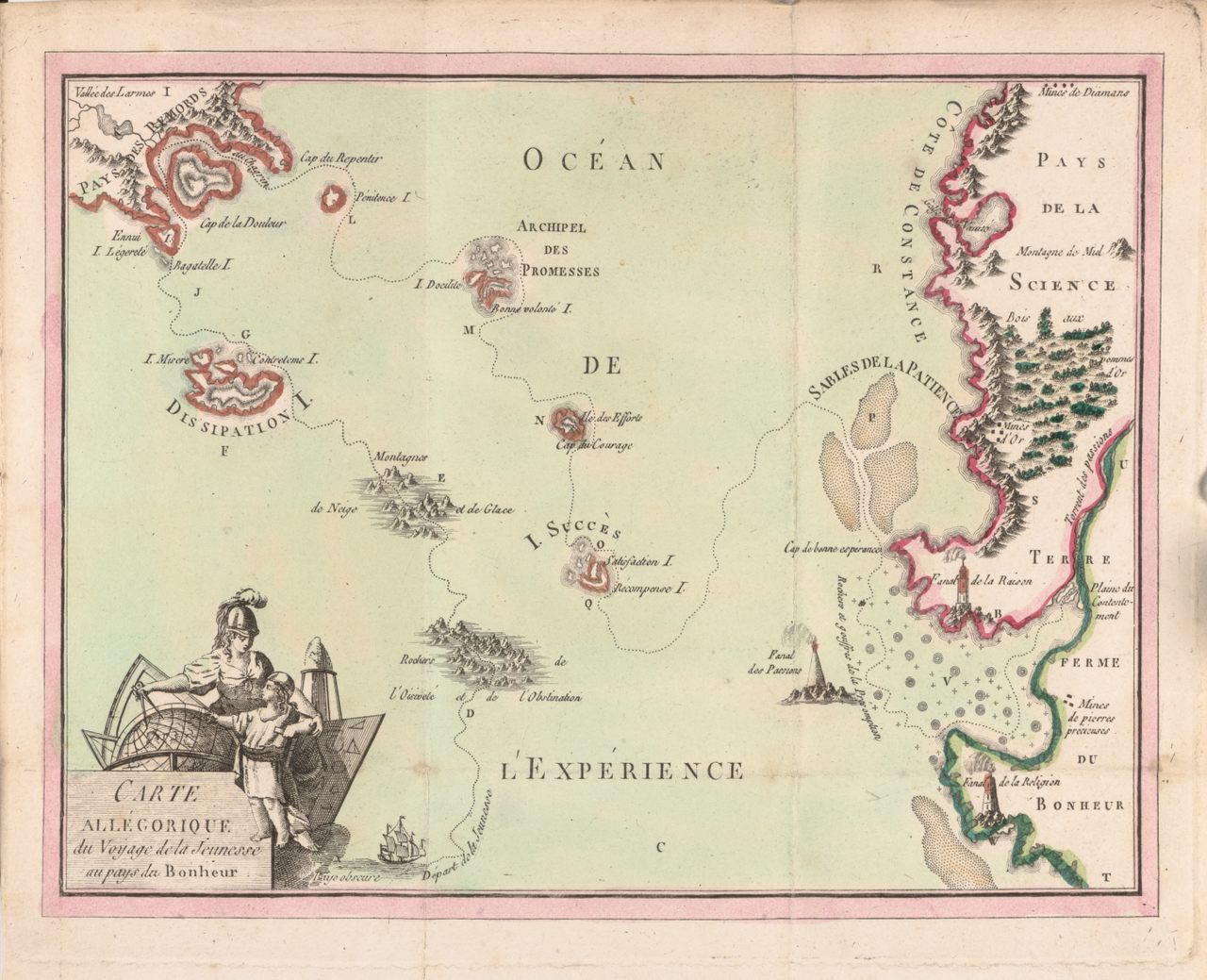Young, Lost, and Hopeless? This Map Will Show You the Way to Happiness
The Ocean of Experience will apparently kick you around, then give you honey and gold mines.
It is a truth universally acknowledged (by adults) that youth is irrevocably lost and in need of guidance. Auguste-Jacques Lemiere-d’Ary, an 18th-century French writer and translator, was no exception to this. He was indeed so worried about the lost ways of youth that he took it upon himself to draw a map to guide them along to happiness.
Published in 1802, the Allegorical Map of Youth’s Journey to the Country of Happiness shows the route that any young person who wants to achieve peace must take. The map is so precise that it not only includes a dotted line specifying all the steps, but also gives each step a letter.
Athena, the Greek goddess of reason, stands at the bottom left-hand corner of the map, wrapping a child in her arms as she shows him how to use a compass to navigate the globe. The message is clear: reason is what will guide youths to success in their endeavors.


We begin at Dark Bay (A), from where all youth is thrown clueless and unprepared into the Ocean of Experience (if this is bringing back unpleasant memories of post-graduation life, know that you are not alone). We are then forced to face the Rocks of Obstination and Dissipation (D), two traits that, allegedly, plague all young people.
Things go further downhill at the Mountains of Snow and Ice (E). From there, we journey onto Dissipation Island where we only find misery and bad times (F and G). But the worst is yet to come, as we leave misery behind only to topple onto the Country of Remorse (K), where there’s ennui, thoughtlessness, the Valley of Tears, and the Cape of Pain. So far, nothing but terrible things have happened.

And so we leave the country from the Cape of Repentment and stumble onto Penitence Island (L). Following the Catholic ideal of confession, this is where Lemiere-d’Ary claims the sun starts to smile.
After repenting, we can head over to the of Archipelago of Promises (M), whose two largest islands are those of Docility and Good Will (do we see a pattern here?). We are now ready for the Isle of Efforts (N), because clearly overcoming all the pain and confusion previously encountered in the journey doesn’t really count. Finally, we arrive at the Island of Success (O), where we find satisfaction and reward.
Don’t kick back and throw yourself on a couch just yet! Because the journey isn’t over with success. Oh, no. We must now conquer the large Sands of Patience (P) and try to get through the triangle formed by the three beacons of happiness: Passion, Reason (B), and Religion (W). The triangle is quite perilous, as it is dotted with the Rocks and Chasm of Presumption (V), which can lead you astray—translation: don’t be a self-absorbed fopdoodle.

If we make it through and get to where the Country of Science (S) and the Firm Land of Happiness (T) converge, we will stumble unto the Torrent of Passions (U). Once there, we have access to the many rewards that experience and old age apparently offer, which include gold and diamond mines, Honey Mountain, and an entire forest filled with golden apples.
While it might now seem contradictory to place science and religion in such close ties, especially as it pertains to the happiness of future generations, the map corresponds with the attitude of the time. During the French Revolution and the Reign of Terror, Catholicism and other religions were abolished and heavily persecuted. Robespierre, whose excessive love of the guillotine locked his own fate under its sharp blade, wanted to replace Catholicism with the Cult of Reason.

However, Napoleon Bonaparte, who championed many causes of the revolution (except, you know, freedom from an authoritarian leader), stopped the persecution of the church and restored some of its civil status a year before the map was published. Though Catholicism would never regain the power it held under the Ancien Regime, the map is evidence of how it affected morals and social attitudes during the First Empire.
Lemiere-d’Ary made this map in an attempt to educate youth and guide them to a life of hard work and morality. If we are to take his word for it, then the happy conclusion is that getting old is wonderful. If ever the passage of time throws you into existential angst, just let this map console you.
Map Monday highlights interesting and unusual cartographic pursuits from around the world and through time. Read more Map Monday posts.








Follow us on Twitter to get the latest on the world's hidden wonders.
Like us on Facebook to get the latest on the world's hidden wonders.
Follow us on Twitter Like us on Facebook